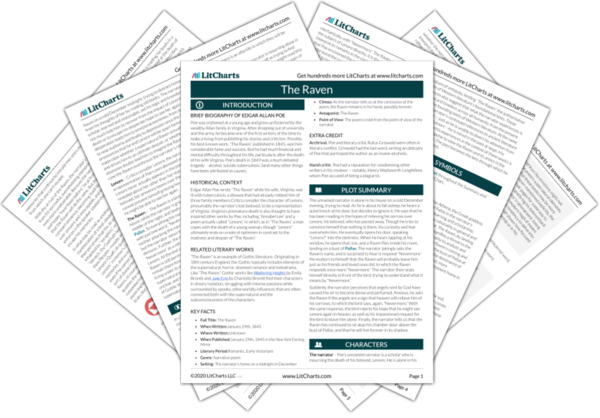Death and the Afterlife
As with many other of Poe’s works, “The Raven” explores death. More specifically, this poem explores the effects of death on the living, such as grief, mourning, and memories of the deceased, as well as a question that so often torments those who have lost loved ones to death: whether there is an afterlife in which they will be reunited with the dead.
At the beginning of the poem, the narrator is mourning alone in…
read analysis of Death and the AfterlifeMemory and Loss
Often, memories of the dead are presented as purely positive – as a way for the departed to continue to exist in the hearts and minds of those who remember them, and as a source of comfort for those who are still alive. “The Raven” flips this notion on its head, envisioning memories of a deceased loved one as a sorrowful, inescapable burden.
As the poem begins, the narrator is struggling to put his anguished…
read analysis of Memory and LossThe Supernatural and the Subconscious
“The Raven” is an example of Gothic literature, a genre that originated in 18th century England. Hallmarks of Gothic works include horror, death, the supernatural, and occasionally romance. Their characters are often highly emotional and secluded from society, living in dark, gloomy, medieval-like homes surrounded by wild natural landscapes. (“Gothic” refers to the architectural style of the residences in which these novels are set.) “The Raven” contains many elements that point to the narrative’s Gothic…
read analysis of The Supernatural and the Subconscious
Rationality and Irrationality
In an essay titled “The Philosophy of Composition,” in which Poe explained his writing of “The Raven,” he describes the narrator as a scholar, a learned person devoted to rational investigation. It is therefore natural for the speaker to attempt to escape his obsessive memories of his wife by reading “ancient lore,” and when he senses Lenore’s presence he comforts himself with the words “Nothing more” to assure himself that a ghost has not…
read analysis of Rationality and IrrationalityAncient Influences
Throughout the poem, Poe makes repeated references to classical mythology and the Bible — “ancient lore” such as what the narrator might have been studying at the beginning of the text. “Pallas,” the bust on which the Raven perches, is a reference to “Pallas Athena,” the Greek goddess of wisdom. Like Pallas Athena, the Raven hails from “the saintly days of yore.” The bird’s choice of landing place illustrates its relationship to ancient…
read analysis of Ancient Influences











